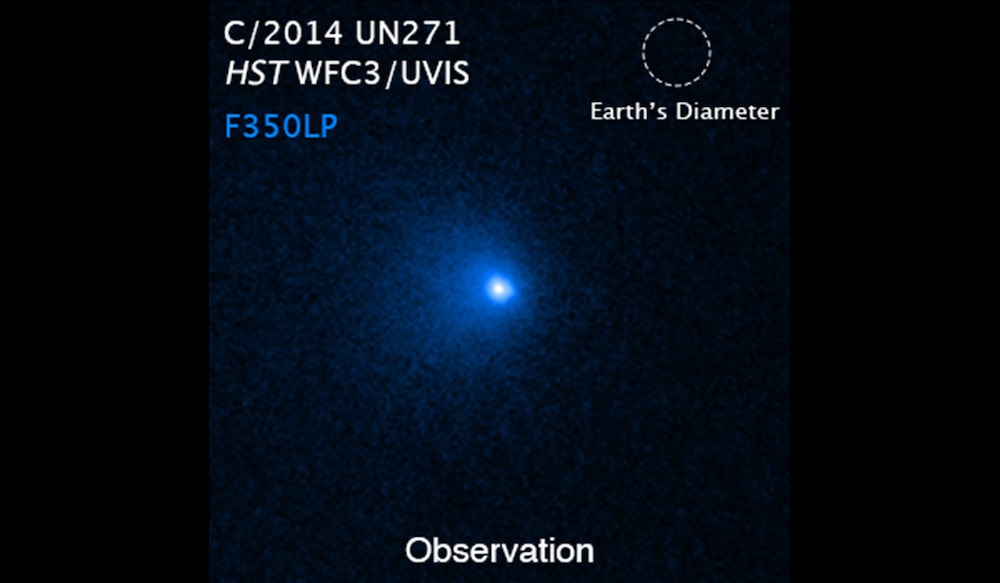Create a free profile to get unlimited access to exclusive videos, sweepstakes, and more!
The biggest comet ever seen shows off its hair for Hubble
UN271 is ~137 km across, bigger than any other object like it ever seen.

Last year, a team of astronomers announced a shocking discovery: While looking through a vast amount of observations of the sky taken by the Dark Energy Survey, they found a comet that is simply huge, a chunk of ice and rock that at the time was estimated to be as much as 150 kilometers across.
Called C/2014 UN271 (Bernardinelli-Bernstein), it’s on an incredibly long orbit that takes it a significant chunk of a light-year from the Sun (!!) but once every three million years or so it drops down to a minimum distance of about 1.6 billion km, just outside the orbit of Saturn.
This makes it not just a Trans-Neptunian Object (or TNO), of which thousands are known, but an actual Oort Cloud comet, an object that comes from a roughly spherical swarm of icy bodies that can be trillions of kilometers from the Sun.
A big — literally — question is, how big is this thing? The initial estimates were made judging by how bright it appears, its distance, and a guess at how reflective it is. But new Hubble Space Telescope observations show that its likely size is roughly 137 ±15 kilometers [link to paper]. Not quite as large as first thought, but still flippin’ huge. Way bigger than any other long-period comet ever seen.
The reflectivity is an issue. At a given distance, a big dark object can be the same brightness as a small shiny one, so getting the size depends on how much sunlight the object reflects, called its albedo. One way around this is to look in the infrared or longer wavelengths, where the object’s brightness only depends on its size and temperature — it glows at those wavelengths due to its own heat. Since it’s warmed by the Sun, the temperature can be found, so the size can be determined.
Observations at very long wavelengths by ALMA combined with the Hubble observations give the size listed above. It’s possible, though, that the solid part of the comet, called the nucleus, is surrounded by a cloud of dust, called the coma — Latin for “hair.” If so that makes it look brighter, so accounting for the maximum likely amount of dust, the astronomers determined that the minimum size of UN271 is 119 ±13 kilometers. That’s still really, really big.
Even so, it’s too small to be very round; the smallest known object in the solar system still big for its gravity to crush it into a sphere is Saturn’s moon Mimas, which is 400 km across. So it’s likely irregular in shape.
And the fact that it has a coma at all is pretty interesting! Comets have a lot of ice in them like frozen water, carbon monoxide, carbon dioxide, and more. As they near the Sun these ices turn directly to gas and flow away from the nucleus. Comets also have a lot of rocks and dust in them, so that too can be carried away by the expanding gas, creating the coma (and, when it’s closer to the Sun, the comet’s tails). But this comet was showing such activity when it was still over 3.5 billion km from the Sun! It’s cold that far out, so seeing a coma is amazing. Some theoretical models show activity can start well over 5 billion km out, so while surprising it’s not impossible.
The Hubble image definitely shows a coma, and the astronomers used a model of what that looks like to subtract it away from the image to reveal the nucleus, though it’s still far too small to see as anything other than a dot, even with Hubble. Still, they were able to calculate how much mass the comet is losing, and while their numbers are uncertain, they find it’s blowing out a staggering one ton of material per second, even at its still enormous distance from the Sun! That’s partly because it’s very active, but also because it’s just so dang big; there’s a lot of surface area there to warm up and emit gas and dust.
Despite its enormous size, there’s nothing to worry about from UN271; it can’t impact Earth since it never gets closer to the Sun than Saturn. An impact from an object that size would be… bad. The dinosaur killer asteroid was about 10 km across. At a minimum UN271 is 10 times wider, so it has 1,000 times the volume and likely would impact at higher speed than the one that ended the Cretaceous Period. I don’t know if anything could survive an impact like that, so good thing UN271 stays over a billion km away.
But scientifically this comet is a treasure. It hasn’t gotten very close to the Sun, so it’s very likely to be in a near-pristine condition, similar to the way it’s been for the past 4.6 billion year history of the solar system. It’s a time capsule to the past, and studying it can tell us a lot about what things were like back then, and what sorts of molecules and minerals existed a trillion kilometers away in the disk of material that formed the Sun, the planets, and the comets.
And it’s still about as far from us as Uranus is, roughly 3 billion km. So it will get closer, brighter, and no doubt show more activity over the years even as it gets to perihelion, the closest point in its orbit to the Sun, in early 2031. You can bet there will be a lot more fun observations made of it, and a lot more to learn from it.





























